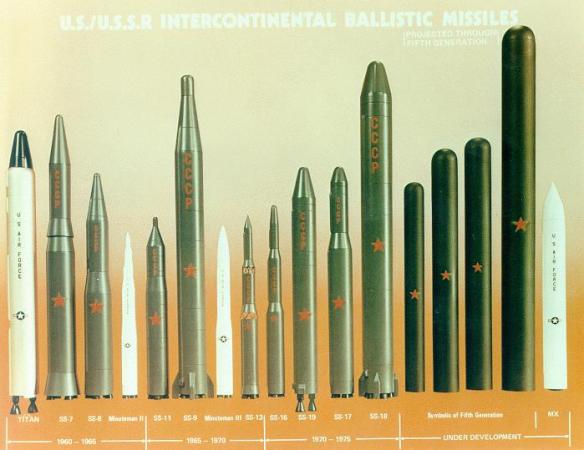Convair won a contract to develop the first U. S. ICBM, the Atlas. Meanwhile, development of nuclear weapons continued. The first thermonuclear device (the hydrogen bomb) was detonated by the United States on November 1, 1952. Because they produced a relatively high yield for a relatively low weight, thermonuclear weapons were the ideal warhead to mount on the ICBMs under development.
After several years of design, development, and testing, the United States deployed the liquid-fueled Atlas ICBM in 1959. The system evolved from a vertical aboveground launch system (gentry tower) to a horizontal aboveground system (coffin launch) and finally to a below ground silo system. Atlas served until 1965. The U. S. Air Force operated Atlas squadrons from California to New York. At one point, the service deployed 72 Atlas F missiles. The Atlas F carried a 4-megaton warhead, and its range was between 6,400 and 9,000 miles. Crews required about 30 minutes to prepare and launch an Atlas.
#
The first intercontinental ballistic missiles (ICBMs), such as the Soviet SS-6, the American Atlas, and the U. S. Titan I and II, were large, liquid-fueled rockets with payloads of 5 to 8 tons, the weight of thermonuclear warheads in the late 1950s. With a single warhead to destroy cities and large military installations, these missiles reaffirmed prevailing strategic assumptions. As smaller replacements, such as the Soviet SS-7, -9, and -11 and the U. S. Minuteman, appeared, the original heavy missiles were retired or reassigned to secondary missions.
The second generation of heavy ICBMs carried large numbers of much smaller reentry vehicles called MIRVs (multiple independently targetable reentry vehicles). The Soviet SS-18 was tested in 1973 with ten MIRVs and had an intercontinental throw weight (payload) of nearly 9 metric tons. This aroused concern in the United States that the Soviet Union would soon be able to destroy American ICBM fields in a disarming first strike using only a small portion of its total missile force. This superiority would make American threats of retaliation less credible.
Controlling heavy ICBMs became a major goal of American arms control efforts in the mid-1970s. The SS-18 was specifically defined as a heavy ICBM under the 1979 treaty resulting from the Strategic Arms Limitation Talks (SALT II). This limited the Soviet Union to no more than 308 heavy ICBMs and forbade testing an ICBM with more than ten warheads. Under the 1993 Strategic Arms Reduction Treaty (START II), destruction of SS-18 silos in Russia and Kazakhstan began in 1993-1994. The last silos were destroyed or converted, with the aid of U. S. funding, by the end of 2003. Decommissioned SS-18 missiles are being converted to service as Dnepr space launch vehicles.
The United States responded to the SS-18 with the MX Peacekeeper (LGM-118A). Although its throw weight was less than 3 tons-which in a technical sense did not make it a “heavy” missile-design innovations enabled the MX to carry ten warheads. Following the recommendations of the 1983 Scowcroft Commission Report, which was chaired by Lieutenant General Brent Scowcroft, USAF (ret.), fifty MX missiles were deployed in existing Minuteman silos. The first became operational in 1986. Under START II, all fifty MX ICBMs must be retired by 2004.
